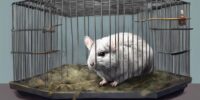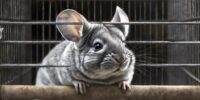What Are the Common Mistakes in Chinchilla Cage Setup and How to Avoid Them
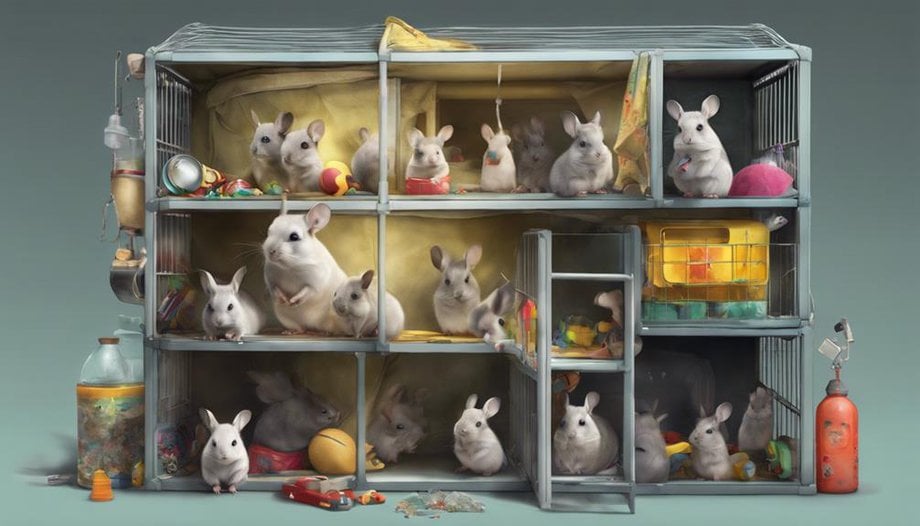
Common Mistakes in Chinchilla Cage Setup and How to Avoid Them:
Ensure proper space, ventilation, enrichment, and maintenance for a harmonious chinchilla habitat.
Key Takeaways
- Ensure proper ventilation to avoid respiratory issues and maintain a healthy environment.
- Provide ample space for exercise and mental stimulation to prevent boredom and promote well-being.
- Select suitable bedding materials for comfort, cleanliness, and odor control in the chinchilla habitat.
- Incorporate hiding spots and enrichment activities for security, stimulation, and a natural habitat feel.
Inadequate Space for Chinchilla
Ensuring ample space for your chinchilla to roam and play is crucial for their physical and essential well-being. Meeting their exercise needs and providing a cage that meets the size requirements are fundamental aspects of responsible chinchilla care.
A chinchilla's spirit yearns for freedom, a vast expanse where they can hop, skip, and jump without constraints. Imagine the joy in their eyes as they explore every nook and cranny of a spacious cage, their furry bodies darting to and fro in a display of pure bliss.
Inadequate space can lead to boredom and even health issues for these lively creatures. A cramped environment stifles their natural instincts, hindering their ability to express themselves fully. Chinchillas are creatures of movement, agility, and curiosity; confining them to a small area goes against their very essence.
Poor Ventilation and Airflow
Amidst the dance of chinchilla care, embracing the gentle breeze of proper ventilation becomes a important melody for their well-being. Improving airflow within a chinchilla's habitat is essential to make certain their health and comfort. Ventilation strategies play a important role in maintaining a conducive environment for these delicate creatures. Here is a guide to help you enhance the airflow in your chinchilla's cage:
| Ventilation Strategy | Description | Benefits |
|---|---|---|
| Proper Cage Placement | Position the cage in a well-ventilated area | Ensures fresh air circulation |
| Mesh Panels | Install mesh panels for increased air circulation | Prevents stuffiness and odors |
| Regular Cleaning Routine | Clean the cage frequently to maintain air quality | Reduces dust buildup |
| Airy Accessories | Opt for breathable accessories like wooden ledges | Promotes better airflow |
Incorrect Bedding Materials Used
Choosing incorrect bedding materials for your chinchilla can greatly impact their health and comfort in their habitat. To make sure a cozy and safe environment, here are some tips on bedding materials:
- Opt for bedding alternatives like paper-based or aspen shavings to avoid respiratory issues caused by dusty materials.
- Prioritize bedding absorption as it helps in maintaining a dry and clean cage, promoting your chinchilla's well-being and comfort.
- Consider bedding materials that aid in odor control to prevent any unpleasant smells from lingering in the cage, making sure a fresh and pleasant atmosphere for you and your furry friend.
Lack of Hiding Spots and Enrichment
In a chinchilla's habitat, providing ample hiding spots and enrichment is essential for their mental stimulation and overall well-being. Chinchillas are curious creatures, craving adventure and exploration in their environment. Without sufficient hiding spots, these small furry friends can feel stressed and anxious. It is vital to create a space that mimics their natural habitat, offering places to retreat and feel secure. Additionally, incorporating enrichment activities such as chew toys, tunnels, and platforms can keep chinchillas engaged and entertained, preventing boredom and promoting physical activity.
| Importance of Hiding Spots | Enrichment Activities |
|---|---|
| Provides security and comfort | Chew toys for dental health |
| Reduces stress levels | Tunnels for exploration |
| Mimics natural habitat | Platforms for exercise |
Wrong Placement of Food and Water
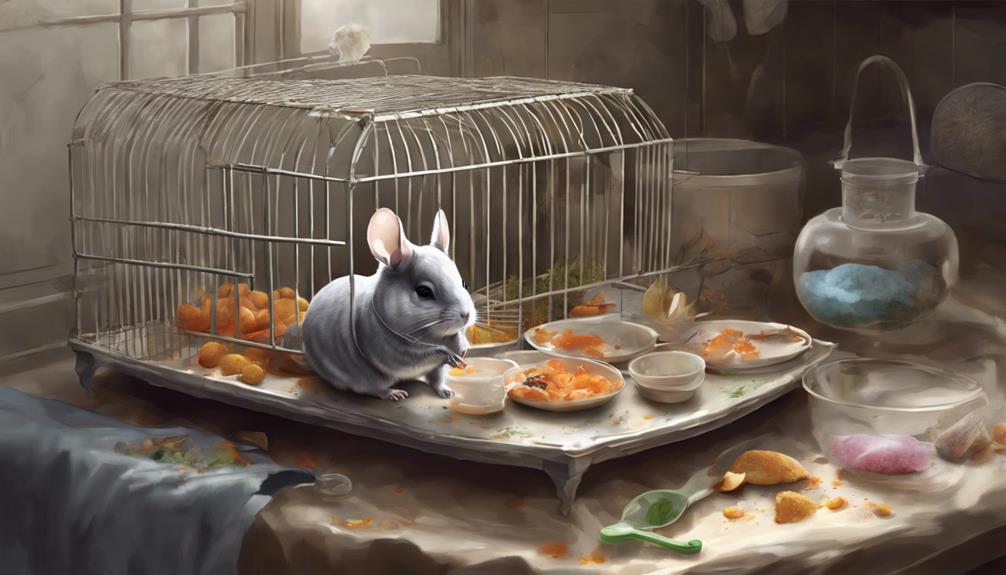
Placing the food bowl and water bottle correctly can make a world of difference in a chinchilla's life. The right positioning guarantees easy access for your furry friend and promotes their well-being.
Food Bowl Placement
Where should one ideally position the food and water bowls in a chinchilla cage to promote their well-being and natural behaviors? When setting up the feeding area for your chinchilla, consider the following:
- Low and Stable: Place the food bowl low to the ground and in a stable position to mimic foraging behavior.
- Separate Locations: Provide separate locations for food and water to prevent contamination and keep their living space clean.
- Quiet Area: Position the bowls in a quiet area of the cage to create a peaceful dining environment for your chinchilla.
Water Bottle Positioning
Position the water bottle in a chinchilla cage with careful consideration to encourage proper hydration and prevent potential issues. The bottle height is vital; make sure it's at a level that allows your chinchilla to comfortably access the water without straining.
Remember, water flow matters too. Check that the spout dispenses water smoothly, without any blockages that could hinder your furry friend's drinking. Incorrect positioning might lead to dehydration or spills, impacting your chinchilla's health and creating unnecessary mess.
Overlooking Cage Cleaning and Maintenance
Neglecting the regular cleaning and upkeep of a chinchilla's cage can lead to health issues and discomfort for the small furry friend. Proper sanitation and regular maintenance are vital for creating a healthy environment for your chinchilla. Here are some important points to take into account:
- Daily Spot Cleaning: Removing any uneaten food, soiled bedding, and droppings on a daily basis helps maintain a clean and hygienic cage environment.
- Weekly Deep Cleaning: A thorough weekly cleaning involving changing all bedding, washing and disinfecting the cage accessories, and scrubbing the cage itself is essential to prevent the buildup of bacteria and odors.
- Monitoring Air Quality: Ensuring good ventilation in the chinchilla's cage and keeping the surrounding area clean can help prevent respiratory issues and promote overall well-being.
Ignoring Temperature and Humidity Levels
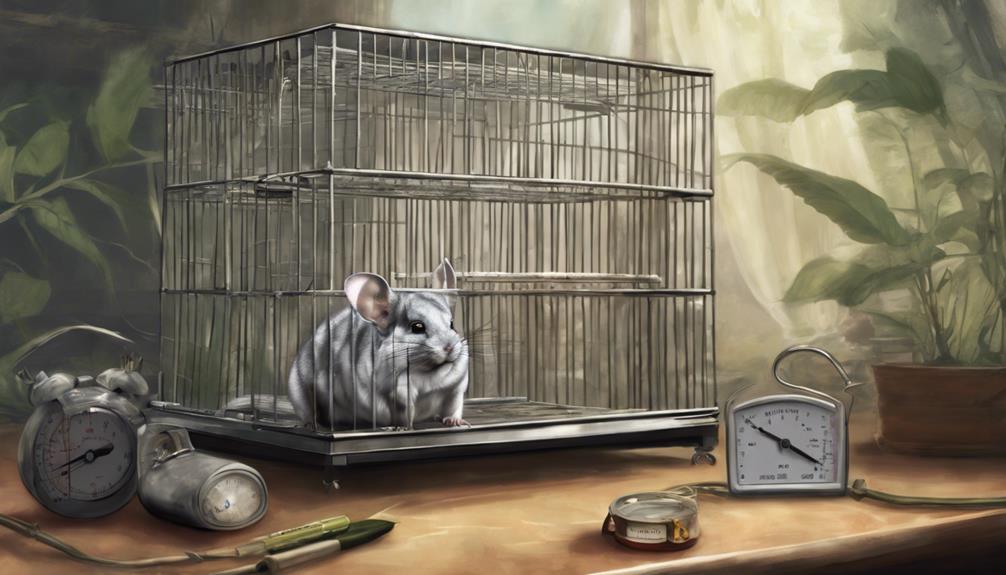
Neglecting temperature and humidity levels in a chinchilla's environment can lead to discomfort and health issues. To guarantee your chinchilla thrives, it's imperative to maintain a consistent temperature, monitor humidity levels, and implement proper ventilation techniques.
Temperature Control Importance
Ensuring proper temperature and humidity levels in a chinchilla's cage is essential for maintaining their health and well-being. In the world of chinchillas, where warmth and coziness reign supreme, temperature regulation takes center stage.
Here are some wise nuggets to keep your fluffy companion content:
- Thermometer Love: Showing some love to that little temperature gauge can make a world of difference.
- Nifty Heating Solutions: From snuggly heat lamps to toasty heating pads, explore the variety of heating solutions available.
- Draft Dodging: Keep those pesky drafts at bay; chinchillas appreciate a steady and gentle flow of air.
Humidity Level Monitoring
An important aspect often overlooked in chinchilla care is monitoring the humidity levels within their cage. Humidity control is essential for these delicate creatures, with levels ideally between 40% to 60%.
High humidity can lead to respiratory issues, while low humidity can cause dry skin and fur problems. Proper ventilation is key to maintaining the right moisture levels within the enclosure. Chinchillas thrive in dry environments, so ensuring adequate airflow is important.
To prevent mold growth and other health issues, it's necessary to keep the humidity in check. By monitoring and regulating humidity levels alongside temperature control, chinchilla owners can create a comfortable and safe habitat for their furry friends.
Proper Ventilation Strategies
Proper ventilation in a chinchilla cage is essential for their well-being and shouldn't be underestimated, as it directly impacts their health and comfort. When setting up ventilation in your chinchilla's habitat, consider these key strategies for the best airflow management:
- Placement of Cage: Position the cage in an area with good air circulation to prevent stagnation.
- Use of Ventilation Accessories: Employ tools like fans or vents to guarantee a continuous flow of fresh air.
- Regular Cleaning: Keep the cage clean to avoid dust buildup that can hinder proper airflow and compromise your chinchilla's respiratory health.
Frequently Asked Questions
Are There Any Specific Chinchilla Breeds That Require More Space in Their Cages Compared to Others?
Chinchilla space requirements vary among breeds, with some needing more cage space than others due to their size and activity levels. When considering cage size, it's essential to research the specific needs of each breed.
Can Using Certain Types of Bedding Materials Affect a Chinchilla's Health in the Long Run?
Like a gentle breeze through a shady forest, choosing the right bedding for a chinchilla can greatly impact its health. Poor ventilation and harmful materials may pose long-term risks, so wise selections are key.
How Can I Ensure That My Chinchilla Has Enough Hiding Spots and Enrichment in Their Cage?
To guarantee a chinchilla has ample hiding spots and enrichment, vary hideout placement to mimic natural behavior. Incorporate different textures, levels, and toys for mental stimulation. A well-thought-out cage layout can promote active engagement and contentment.
Is It Possible for Chinchillas to Get Sick From Consuming Food and Water That Is Placed Incorrectly in Their Cage?
Improper food and water placement in a chinchilla's cage can lead to health risks. If left unchecked, dirty surroundings can pave the way for sickness. Wise chinchilla owners guarantee cleanliness, preventing potential harm.
How Often Should I Clean My Chinchilla's Cage to Maintain a Healthy Living Environment for Them?
To maintain a healthy living environment, one should clean a chinchilla's cage regularly. Neglecting cage maintenance can lead to health hazards. Frequency in cleaning guarantees a safe and happy space for these furry friends to thrive in.

